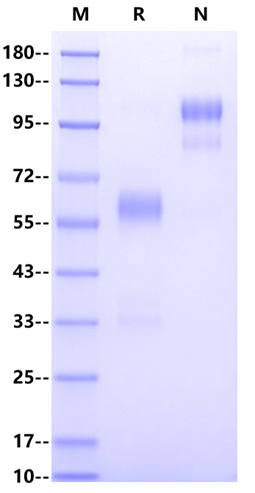Ala26-Lys136, with C-terminal human IgG Fc AQVMDFLFEKWKLYGDQCHHNLSLLPPPTELVCNRTFDKYSCWPDTPANTTANISCPWYLPWHHKVQHRFVFKRCGPDGQWVRGPRGQPWRDASQCQMDGEEIEVQKEVAKIEGRMDPKSSDKTHTCPPCPAPELLGGPSVFLFPPKPKDTLMISRTPEVTCVVVDVSHEDPEVKFNWYVDGVEVHNAKTKPREEQYNSTYRVVSVLTVLHQDWLNGKEYKCKVSNKALPAPIEKTISKAKGQPREPQVYTLPPSRDELTKNQVSLTCLVKGFYPSDIAVEWESNGQPENNYKTTPPVLDSDGSFFLYSKLTVDKSRWQQGNVFSCSVMHEALHNHYTQKSLSLSPGK
57-67 kDa(Reducing)
>90% by SDS-PAGE
Reconstitute at 0.1-1 mg/ml according to the size in ultrapure water after rapid centrifugation.
The glucagon receptor (GCGR) is a Class B GPCR that has an important role in maintenance of glucose homeostasis and, as such, is considered to be a valuable target for the treatment of diabetes. The GCGR is widely expressed and can be found in the liver, adipose tissue, heart, kidney, pancreatic islets, stomach, small intestine, thyroid, and skeletal muscle. The GCGR is coupled to the activation of adenylate cyclase via Gs, with concomitant rise in cellular cyclic AMP levels and activation of protein kinase A (PKA). GCGR mRNA has been detected in islets. In vitro/ex vivo studies suggest that glucagon potentiates insulin secretion from isolated islets, although the potency is considerably less than that of the insulin secretagogue GLP-1. Mutations of the GCGR gene are associated with congenital noninsulin-dependent diabetes, and inhibition of GCGR in vivo lowers blood glucose and improves glucose tolerance in obese diabetic mice.


Immobilized GCGR FC Chimera, Human (Cat. No. UA010051) at 2.0μg/mL (100μL/well) can bind Biotinylated Crotedumab with EC50 of 2.81-4.32ng/mL.